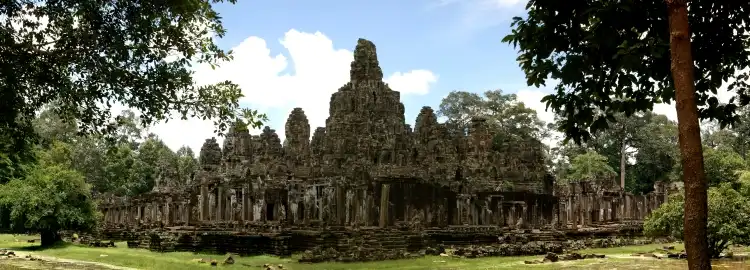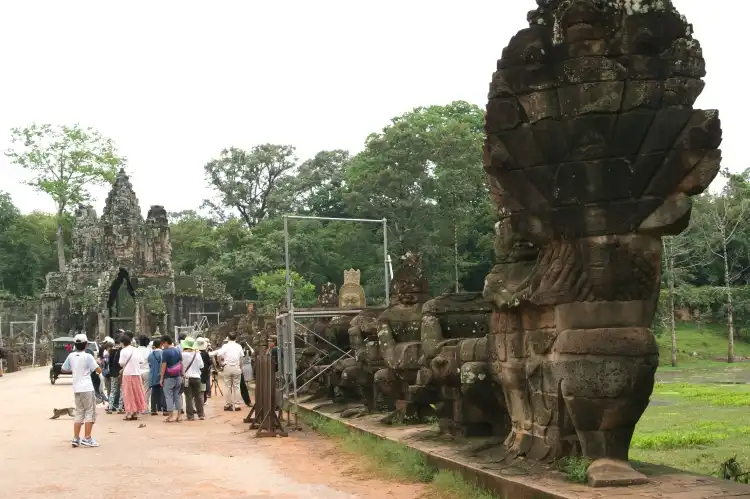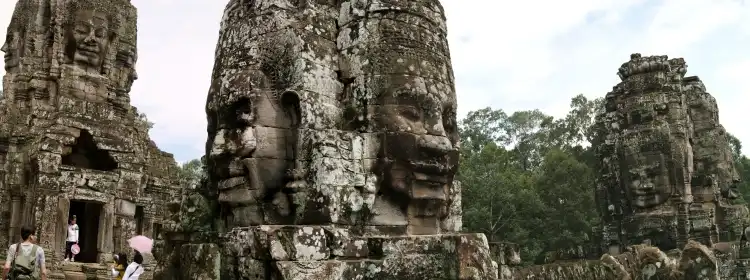Angkor Thom and Bayon stand as enduring symbols of Cambodia’s glorious past. Their grandeur and mystery continue to captivate and intrigue visitors from around the world, offering a window into the soul of the Khmer empire.

The Last Capital and Its Enigmatic Faces
Angkor Thom: The Majestic City
Angkor Thom, the last and most enduring capital city of the Khmer empire, stands as a monumental testament to Cambodia’s rich history. Founded by King Jayavarman VII in the late 12th century, this ancient city was the center of his massive building program. Enclosed by massive walls and a moat, Angkor Thom was designed to represent the universe in stone, mirroring the cosmic world.
The City’s Grand Entrance
The city is accessible through five grand gates, each adorned with impressive stone faces and figures of gods and demons. The South Gate, the most famous, serves as the main entrance, offering a preview of the marvels within. Crossing the causeway lined with statues depicting the churning of the ocean of milk sets the tone for the awe-inspiring sights that await.

Bayon: The Temple of Faces
At the heart of Angkor Thom lies the Bayon Temple, known for its serene and smiling stone faces. This temple, unlike any other at Angkor, is a symbolic representation of the intersection of heaven and earth. The Bayon’s most distinctive feature is the more than 200 gigantic faces carved on the 54 towers. The faces gaze down with an enigmatic smile. They are believed to be either the face of King Jayavarman VII or that of the bodhisattva Avalokiteshvara. Or perhaps a combination of both.

Exploring the Bayon
Visitors to the Bayon can wander through its complex interior and exterior galleries. The outer galleries showcase intricate bas-reliefs depicting historical events and daily life in the Khmer empire. It offers a glimpse into the past. The central sanctuary, with its labyrinth of corridors, courtyards, and chambers, invites exploration and contemplation.
Angkor Thom’s Other Highlights
Beyond Bayon, Angkor Thom is home to other notable structures. The Terrace of the Elephants and the Terrace of the Leper King were used for public ceremonies and are adorned with detailed carvings. Phimeanakas, Baphuon, and Preah Palilay offer further insights into the architectural and religious complexity of the Khmer empire.

Visiting Tips
Angkor Thom is best explored early in the morning or late in the afternoon to avoid the heat and crowds. Hiring a knowledgeable guide enhances the experience, providing insights into the history, architecture, and symbolism of these ancient wonders.
Cultural Respect
When visiting, it’s important to dress modestly and behave respectfully. These sites are not only tourist attractions but also places of cultural and spiritual significance.
Tours
Most of the Angkor Wat tours also include a visit to Angkor Thom. Group tours and private tours are available, but flexible private tours are recommended.
Private Temples Guided Tour (Angkor Wat, Ta Prom & Angkor Thom) is a concise tour covering three major temples.
Comments
3 responses to “Angkor Thom and Bayon”
[…] eastern pagoda has the same form as Bayon and has the four faces of Avalokiteshvara […]
[…] named T, U, V, W, and X. Each temple features distinct carvings and layouts.It sits in the heart of Angkor Thom. This site is less known but offers a unique glimpse into ancient Khmer […]
[…] circuit includes Angkor Wat, Phnom Bakheng, Angkor Thom, South Gate, Baphuon, Phimeanakas, Terrace of the Leper King, Terrace of the Elephants, Victory […]